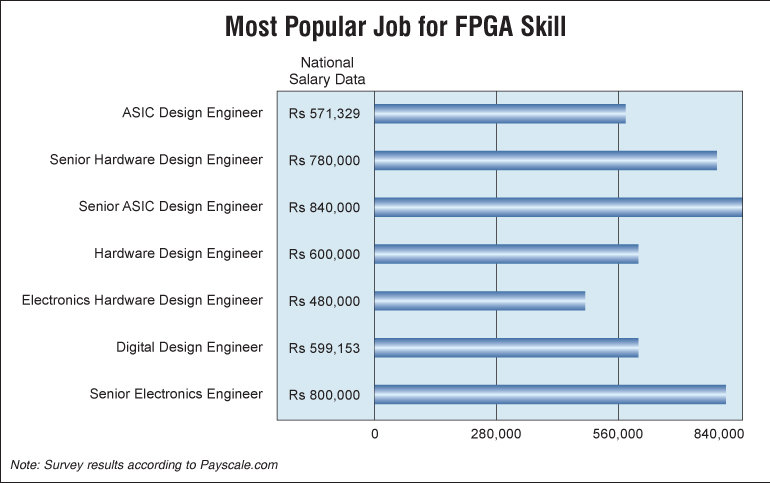The job situation in field-programmable gate arrays (FPGAs) has seen an uptrend in the last few years due to increase in their use in different areas. An FPGA is an integrated circuit designed to be configured by the customer or designer after manufacture. The FPGA configuration is generally specified using a hardware description language (HDL).
FPGAs were first introduced into the market about 25 years ago and back then, it was a very simple technology. In the last few years, there are two main factors that have changed the landscape for the better.
“Earlier, people could easily create any logic on FPGAs, but now these are more technical in nature,” says Sanjay Churiwala, director, ADVS, Xilinx India.
“FPGAs today come with high-speed interfaces and serial communication protocols. Since these are more capable technically, they allow users to develop complex products and designs that were not possible before. Application-specific integrated circuits are an alternative to FPGAs that were commonly used before. But not many markets can expect such high returns and hence more people opt to work on FPGAs instead. As a result, there has been a huge increase in job opportunities for FPGA engineers,” Churiwala adds.
Today, design development at the block level is mostly independent of target implementation. Vasudevan Aghoramoorthy, vice president, semiconductor and systems, Wipro Technologies, explains, ‘’FPGAs have increasingly become the choice for new technology and low-volume products across markets like telecommunication infrastructure, industrial automation, aerospace and defense, and next-generation consumer electronics.”
As per semiconductor industry data, the total global programmable market was worth close to $5.1 billion in 2011, with $4 billion coming from FPGAs.
“We expect India to grow as a market for engineers equipped with FPGA skillset. In the coming years, engineers equipped with FPGA skillset will be in demand at two levels—technology/block development and implementation. From a technology standpoint, such skillset would be needed for block development and validation of custom differentiating and reusable hardware logic. Secondly, from an implementation standpoint, they will be in demand to achieve optimisation for high device utilisation and performance,” Aghoramoorthy adds.
The popular FPGAs available in the market are manufactured by companies like Xilinx, Lattice and Altera. Apart from FPGA manufacturers, candidates can also consider working for organisations that design around FPGAs. These include Cisco, Juniper, Samsung and Tejas Networks. Firms like National Instruments, Wipro and Infosys too have divisions for FPGA engineers.
This line offers creative and challenging work, which involves rapid prototyping of design ideas as well as verification of existing designs. Almost any area with design and verification tasks will have a requirement for FPGA-trained VLSI engineers to prototype the solutions of FPGA-based systems.
“FPGAs can be bought and programmed for a particular application. These are mostly used in embedded computing systems. All levels of companies—be it a manufacturer of high-end products like automobiles and cellphones, or low-end household equipment like coffee vending machines and toys—have FPGAs in their system,” shares professor M. Balakrishnan, deputy director, department of computer science and engineering.
Balakrishnan explains with an example: “If a car manufacturing company wants to manufacture a new technology for a car, it will opt for an FPGA-based design for prototyping as it is available for $5-10. It must have a good understanding of Verilog or VHDL language to design the slate, as FPGAs are a lot like a blank slate. The FPGA design engineer’s responsibility lies in synthesising different components inside and integrating them together.”
A professor from IIT Bombay explains the role of an FPGA engineer: “A fresher’s job will involve activities like testing, emulation and verification, while an expert in FPGA will be asked to handle digital system design, system-on-chip, embedded hardware-software co-design, digital communication sub-systems, hardware accelerators for various computing tasks, embedded control systems and digital signal processing sub-systems/systems.”
Rajesh Choudhary, head of HR, Xilinx India, adds, “Their work spans across areas like software tool development, system design, IP design and IC design. They are expected to work in domains like bio-medical, video surveillance, embedded systems and communication system. They can grow into senior design engineers and project leads. Soft skills start coming into the picture with managerial responsibility.”
Must-have skills
 Good digital electronics design skills, knowledge of programming platforms, a strong curriculum in VLSI design, good domain knowledge of digital signal processing or digital communications, computing architectures, control systems or appropriate engineering knowledge can take you a long way in getting hired by a good employer. Design work requires good understanding of the problem, not just programming or circuit design skills.
Good digital electronics design skills, knowledge of programming platforms, a strong curriculum in VLSI design, good domain knowledge of digital signal processing or digital communications, computing architectures, control systems or appropriate engineering knowledge can take you a long way in getting hired by a good employer. Design work requires good understanding of the problem, not just programming or circuit design skills.
Where to study
To get an entry to work at Xilinx, a bachelor’s degree in electronics, electrical or computer science is compulsory. However, there is no pressure to take a postgraduation degree or specialisation for the same as the required topics are covered during graduation.






